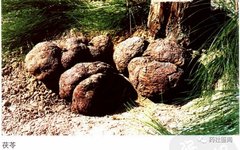This product is the dried sclerotium of the fungus Poria cocos (Schw.) Wolf, belonging to the family Polyporaceae. It is harvested from July to September. After excavation, the soil and sand are removed, and it is piled for "sweating". It is then spread out to dry until the surface is dry, followed by repeated "sweating" until wrinkles appear and most of the internal moisture is lost, after which it is dried in the shade, referred to as "Fuling ge"; or fresh Poria is cut into different parts and dried in the shade, referred to as "Fuling kuai" and "Fuling pian" respectively.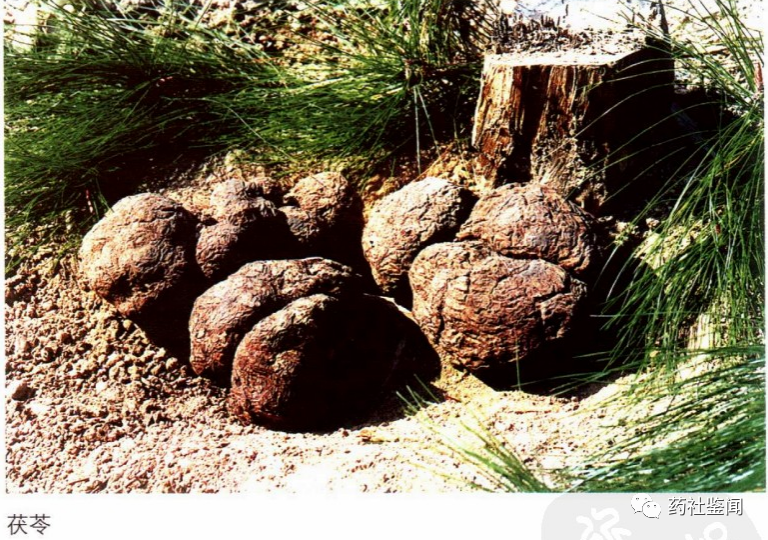
| 【Name】 | Poria |
| 【Pinyin】 | Fuling |
| 【English】 | Indian Buead Tuckahoe |
| 【Latin】 | Poria |
| 【Category】 | Fungi |
| 【Source】 | The dried sclerotium of the fungus Poria Poria cocos (Schw.) Wolf. |
| 【Origin】 | Mainly produced in Anhui, Jiangxi, Jiangsu, Zhejiang, and other regions. |
| 【Characteristics】 | The common form is its sclerotium, which is irregularly shaped, spherical, flat, elongated, or oval, varying in size from as small as a fist to a diameter of 20-30 cm or larger. The surface is light gray-brown or black-brown, with a lumpy, wrinkled appearance, and the interior is white with a slight pink hue, composed of numerous hyphae. The fruiting body is umbrella-shaped, with a diameter of 0.5-2 mm, and the edge is slightly serrated; the sexual generation is rarely seen, and it is honeycomb-like, usually growing on the outer skin of the sclerotium, initially white, gradually turning light brown, with pores that are polygonal, and the basidia are rod-shaped, with basidiospores that are oval to cylindrical, slightly curved, with one end pointed, smooth, and colorless. It has a distinctive odor. |
| 【Quality】 | The best quality is characterized by a solid weight, brownish outer skin, fine skin texture, no cracks, a white and delicate cross-section, and strong adhesive properties. |
| 【Flavor and Properties】 | Sweet, bland, neutral. |
| 【Functions】 | Promotes urination and leaches dampness, strengthens the spleen and harmonizes the stomach, calms the mind and settles the spirit. Indicated for urinary difficulty; edema and fullness; phlegm and cough; vomiting; spleen deficiency with poor appetite; diarrhea; palpitations and anxiety; insomnia and forgetfulness; nocturnal emissions with turbid discharge. |
| 【Processed Products】 | Poria skin: The outer skin of the sclerotium, elongated, varying in size, softer in texture, slightly elastic, functions to promote urination and reduce edema. Red Poria: The light red part after removing the outer skin, functions to leach dampness and clear heat. White Poria: The white part after cutting away the red Poria, also known as Poria kuai, cut into small cubes, functions to leach dampness and strengthen the spleen. Fushen wood: The white Poria with fine pine roots in the center, cut into square thin slices, functions to calm the mind and settle the spirit. |
【Characteristics】 Fuling ge is spherical, oval, flat, or irregularly lumped, varying in size. The outer skin is thin and rough, brownish to blackish-brown, with distinct wrinkled texture. It is heavy, solid, with a granular cross-section, some with cracks, the outer layer is light brown, the interior is white, with some light red, and some contain pine roots in the center. It has a faint odor, a bland taste, and is sticky when chewed.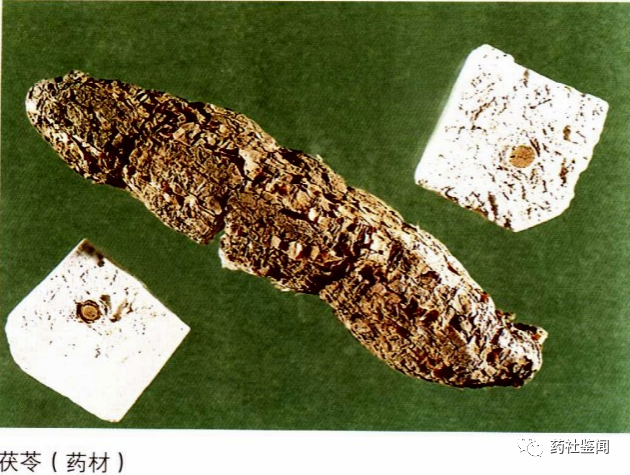
Fuling kuai is the cut Poria after removing the skin, in cubic or thick slice form, varying in size. White, light red, or light brown.
Fuling pian is the cut Poria after removing the skin, in irregular thick slices, varying in thickness. White, light red, or light brown. 【Identification】 (1) The powder of this product is grayish-white. Irregular granules and branched granules are colorless and gradually dissolve when encountering water and chloroform. The hyphae are colorless or light brown, slender, slightly curved, branched, with a diameter of 3-8 μm, some up to 16 μm.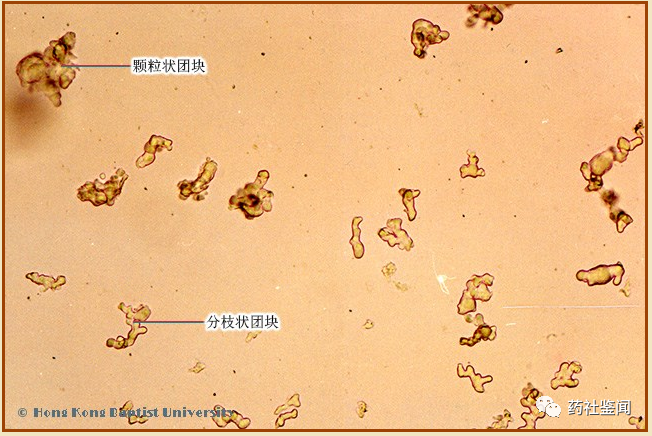
(2) Take a small amount of the powder, add one drop of potassium iodide solution, and it shows a deep red color. (3) Take 1 g of the powder, add 50 ml of ether, ultrasonic treatment for 10 minutes, filter, evaporate the filtrate, dissolve the residue in 1 ml of methanol as the test solution. Take 1 g of Poria as a control herb and prepare the control solution in the same way. Perform thin-layer chromatography (General Rule 0502), applying 2 μl of each solution on the same silica gel G plate, using toluene-ethyl acetate-formic acid (20:5:0.5) as the developing agent, develop, remove, dry, and spray with a 2% vanillin-sulfuric acid solution-ethanol (4:1) mixture, heating at 105°C until the spots are clearly visible. In the test solution, the main spots showing the same color as the control herb's chromatogram appear at corresponding positions. 【Examination】 Moisture content must not exceed 18.0% (General Rule 0832, Method 2). Total ash content must not exceed 2.0% (General Rule 2302). 【Extractable matter】 Determined by the method for determining alcohol-soluble extract (General Rule 2201) using hot extraction, must not be less than 2.5%.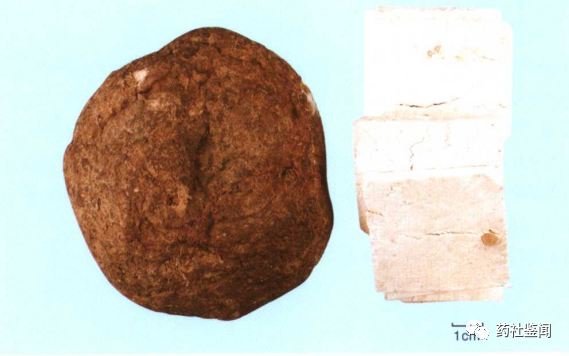
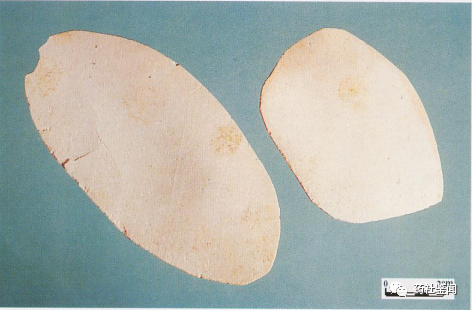
【Preparation】 Take Fuling ge, soak, wash, moisten, steam slightly, promptly peel, cut into blocks or thick slices, and dry in the sun.
【Characteristics】【Identification】【Examination】【Extractable matter】 same as the raw material. 【Flavor and Properties】 Sweet, bland, neutral. Enters the Heart, Lung, Spleen, and Kidney meridians. 【Functions and Indications】 Promotes urination and leaches dampness, strengthens the spleen, calms the mind. Used for edema and reduced urination, phlegm and dizziness, spleen deficiency with poor appetite, loose stools and diarrhea, anxiety, and insomnia. 【Dosage】 10-15 g. 【Storage】 Store in a dry place, protect from moisture.2. Authenticity Identification
1. Authentic Poria The medicinal material is the dried sclerotium of the fungus Poria cocos (Schw.) Wolf. The products are commonly divided into Fuling ge, Fuling pi, Fuling kuai, Fushen kuai, and Fushen mu. Fuling ge is spherical, oval, flat, or irregularly lumped, varying in size. The outer skin is thin and rough, brownish to blackish-brown, with distinct wrinkled texture. It is heavy, solid, with a granular cross-section, some with cracks, the outer layer is light brown, the interior is white, with some light red, and some contain pine roots in the center. It has no odor, a bland taste, and is sticky when chewed. Fuling pi is the outer skin of Poria, varying in shape and size. The outer side is brownish to blackish-brown, and the inner side is white or light brown. It is softer in texture, slightly elastic. Fuling kuai is the cut Poria after removing the skin, in block form, varying in size. White, light red, or light brown. Fushen kuai is the Poria cut into flat square blocks after removing the skin. The color is uniform, each block contains pine wood heart. The thickness is 0.4 cm to 0.6 cm, length and width 4 cm to 5 cm. The wood heart diameter does not exceed 1.5 cm. Fushen mu: This product is the pine wood that grows in the center of Poria, mostly curved and not straight, each root must carry 2/3 of the Poria flesh.3. Specifications and Grades
1. Specifications Poria medicinal materials are classified based on different trading categories during circulation. Note: According to processing methods and appearance characteristics, Poria medicinal materials are divided into ten specifications: "ge ling", "Fuling pian", "Bai ling kuai", "Bai ling ding", "Bai sui ling", "Chi ling kuai", "Chi ling ding", "Chi sui ling", "Fuling juan", "Fuling pao pian". 2. Grades Under each specification of Poria medicinal materials, the trading varieties are classified based on quality. Note: Based on color, texture, etc., the selected goods are divided into "first grade" and "second grade". 3. Fuling ge After excavation, the soil and sand are removed, and it is piled for "sweating". It is then spread out to dry until the surface is dry, followed by repeated "sweating" until wrinkles appear and most of the internal moisture is lost, after which it is dried in the shade. 4. Fuling pian (Bai ling pian) is the Poria after removing the skin, cut into thin slices. White or grayish-white. Fine texture. Mostly rectangular or square, also irregular polygonal. Edged or frayed. 5. Bai ling kuai is the Poria after removing the skin, cut into flat square blocks. White or grayish-white. The edges of the blocks may not be square. There may be fragments larger than 1.5 cm. No impurities or mold. 6. Bai ling ding is the Poria after removing the skin, cut into square blocks. White or grayish-white. Solid texture. Length, width, and thickness within 1 cm, uniform and neat. There may be irregular fragments, but not exceeding 10%. No powder, impurities, or mold. 7. Bai sui ling is the white or grayish-white small fragments or flakes produced during the processing of Poria. 8. Chi ling kuai is the Poria cut into flat square blocks after removing the skin, light red or light brown, the edges may not be square, with fragments larger than 1.5 cm. No impurities or mold. 9. Chi ling ding is the Poria cut into square blocks after removing the skin, light red or light brown, soft texture, length, width, and thickness within 1 cm, uniform and neat, with irregular fragments, no powder, impurities, or mold. 10. Chi sui ling is the light red or light brown small fragments or flakes produced during the processing of Poria. 11. Fuling juan is the Poria cut into rolled thin slices, white or grayish-white, fine texture. 12. Fuling pao pian is the Poria after removing the skin, cut into thin slices, in irregular rolled form, white or grayish-white, fine texture. 13. Sweating is a processing method during which the medicinal material is piled to generate heat after drying to a certain extent, allowing internal moisture to escape, facilitating drying, softening the material, changing its color, enhancing fragrance, or reducing irritation. 14. Water rust refers to the reddish spots on the surface of Poria resembling rust. 15. Specification and grade classification. 16. Requirements In addition to complying with the provisions of T/CACM 1021.1-2016 Chapter 7, it must also meet the following requirements: - No discoloration; - No insect damage; - No mold; - Impurities less than 3%.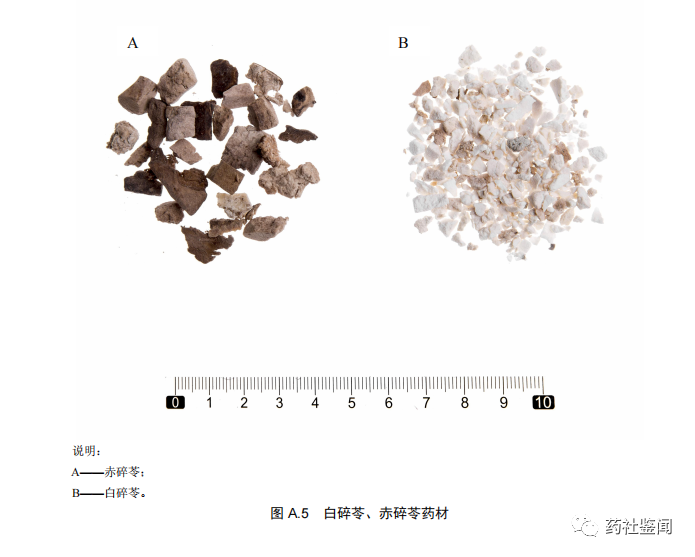
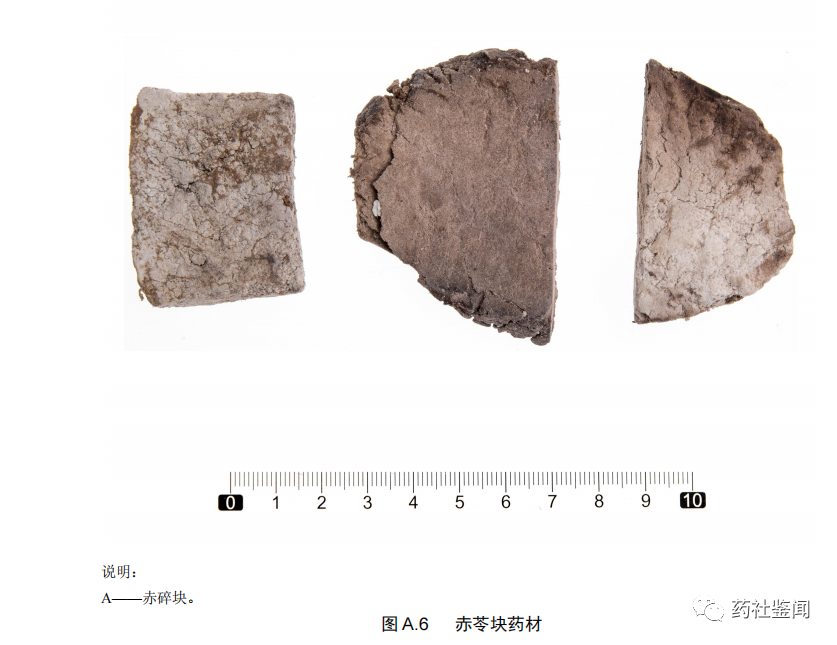
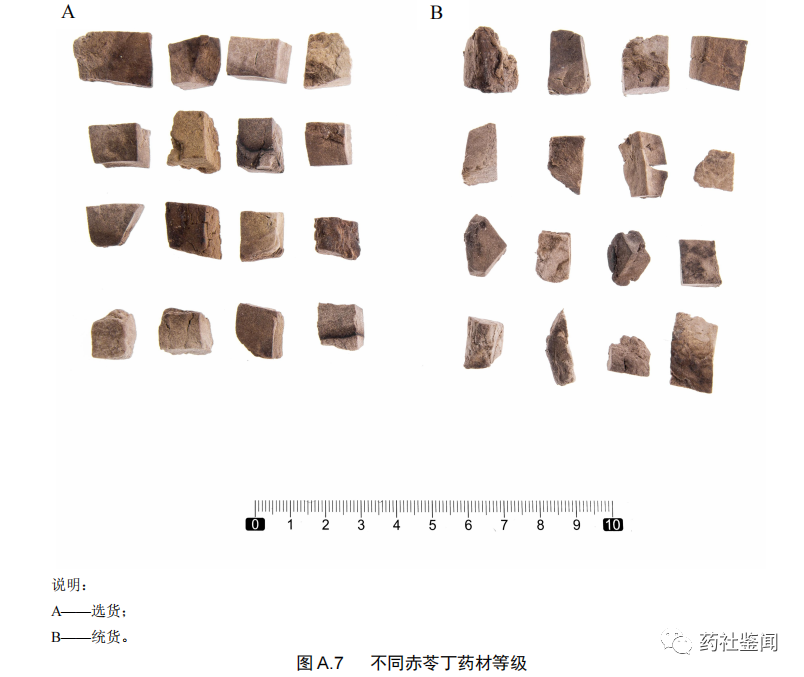
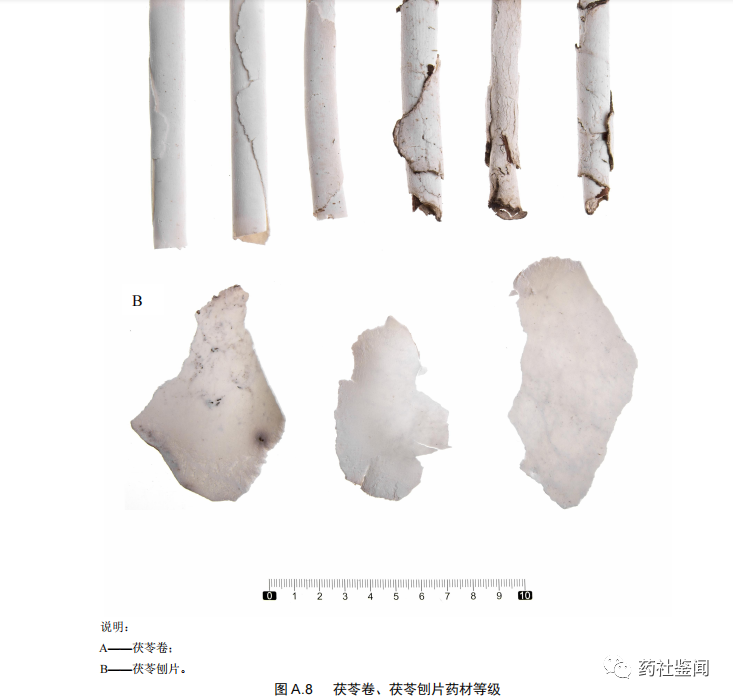
5. Historical Development
In the “Shennong Bencao Jing”, Poria is referred to as “growing in mountain valleys”.
In the Han Dynasty’s “Mingyi Bielu”, it is recorded that “those with roots are called Fushen, growing under the large pines of Taishan”, where Taishan refers to the current Mount Tai in Shandong.
In the Southern and Northern Dynasties, Tao Hongjing’s “Bencao Jing Jizhu” states that “it is now produced in Yuzhou”, which is present-day Lianyungang City in Zhejiang.
In the early Song Dynasty, the “Bencao Tujing” pointed out that the production areas included Taishan, Huashan, and Songshan, involving present-day Shandong, Shaanxi, and Henan provinces.
In the Northern Song Dynasty, the “Zhenglei Bencao” recorded that Taishan Poria was no longer used, with Huashan being the first, and Yongzhou’s Nanshan was not as good. This indicates that during the Song Dynasty, Huashan was recognized as the best production area, establishing the concept of authentic medicinal materials.
In the Southern Song Dynasty, the “Baoqing Bencao Zhezhong” states that “growing under the large pines of Taishan, as well as in Songshan, Sanfu, Taihua, and Xijing, Yuzhou” includes the production areas of present-day Songshan, central, western, and southern Shaanxi, Luoyang in Henan, and Lianyungang in Jiangsu.
In the Ming Dynasty, “Taiyi Xian Zhi Bencao Yaoxing Daquan” states that “those from Yunnan and Guizhou are the best”, marking the earliest record of “Yunling” as an authentic medicinal material.
In the Qing Dynasty, “Bencao Congxin” states that it “is produced in Yunnan. The best is white and solid. Remove the skin. (Those from Zhejiang, although white, are soft and their efficacy is very weak; in recent times, many varieties of Poria have been cultivated, and their efficacy is even weaker.)” This shows that during the Qing Dynasty, the authenticity of Yunling was already recognized, and its efficacy was compared with other production areas.
In the “Zhonghua Bencao”, it is stated that it is distributed in Jilin, Anhui, Zhejiang, Fujian, Taiwan, Henan, Hubei, Guangxi, Sichuan, Guizhou, and Yunnan.

